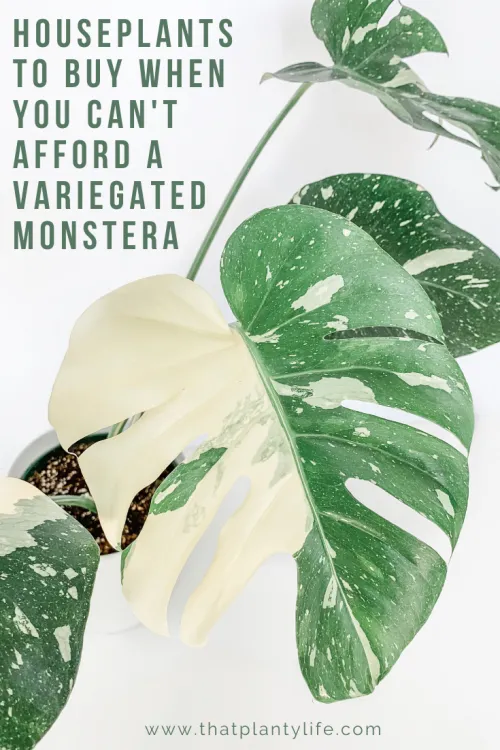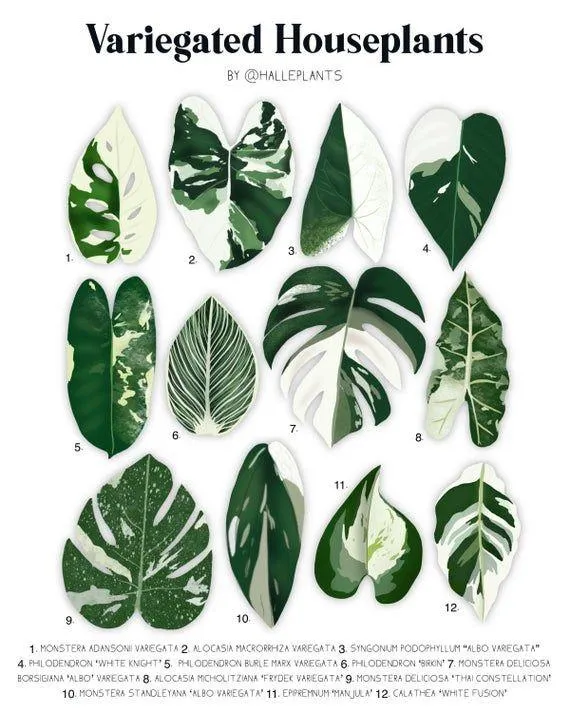A Complete Guide to Variegating Your Plants
Many plant enthusiasts enjoy bringing unique varieties into their home or garden. Variegation is a great way to introduce striking color patterns that will stand out from the crowd. If you’re wondering how to variegate an existing plant, keep reading for answers to all your variagation questions.
What is Variegation?
Variegation refers to colored or whitish markings that appear on plant leaves, stems or flowers. These patterns are caused by a genetic mutation that prevents chloroplasts from developing normally in certain plant tissues. Without chloroplasts to perform photosynthesis, variegated areas remain pale instead of green.
From my experience as a gardener, variegated plants can range from subtle hints of yellow or cream to bold stripes and splashes of color. Some popular variegated varieties include yellow- or white-flecked hostas, striped philodendrons, and golden pothos vines splashed with white. Their unique patterns make variegated greenery a real eye-catcher.
What Causes Natural Variegation?
Though variegation is often considered an abnormality, several natural causes actually produce variegated plants:
- Chloroplast Mutations: As mentioned, genetic mutations prevent chloroplast formation in some plant cells.
- Virus Infections: Certain viruses alter chloroplast genes, blocking photosynthesis and variegating leaves.
- Chimeras: Parts of a chimera plant’s tissues developed from different original cell lines with separate genetic composition.
- Budding and Grafting: Techniques like budding and grafting can introduce differing genetic material, creating variegation.
These natural processes give landscape designers a beautiful palette to work with. However, achieving variegation through propagation requires human intervention.
Can You Create Variegation Through Propagation?
The short answer is yes – with the right techniques, you can variegate a plant that was previously all green. Here are a few common methods:
Cutting Propagation: Taking cuttings from a variegated section of a plant and rooting them is a reliable way to reproduce that variegation. Choose trimmings with both green and white patterns.
Tissue Culture: A laboratory process that grows new plants from tiny plant parts. Tissue culturists can select variegated cell lines to proliferate.
Grafting: Grafting a variegated scion wood section onto a rooted plant stock transmits the mutation. This works well with woody-stemmed plants.
Budding: Similar to grafting but uses dormant bud scales instead of whole scion wood. Requires skill but can variegate some difficult-to-root specimens.
With patience and a green thumb, you have a good chance of passing along variegation through these propagation techniques. Let’s move on to some real-life examples.
Variegating Plants in Practice: Four Case Studies
Case 1: Spider Plant
I once had a lovely variegated spider plant, but wanted to spread the colorful mutation. Using cuttings, I rooted several plantlets with the same white and green patterns on their grass-like leaves. They’ve thrived for years, reminding me of that first special plant.

Case 2: Red-Edged Dracaena
A coworker wanted to variegate her dracaena, known for its long, strap-like leaves. Upon seeing my spider plant success, she took cuttings from a branch with reddish edges. Most rooted, retaining the eye-catching color. There’s no limit to the plants we can bring more beauty to!
Case 3: Golden Pothos
Golden pothos is commonly variegated, so transferring that trait seemed easy. However, after numerous cuttings and grafts, all reverted to solid green. I realized keeping variegation stable takes unique genetics—not all plants pass it on reliably. Genotype matters!
Case 4: Chinese Evergreen
A local greenhouse specialized in tissue-cultured Chinese evergreens with unusual patterns. They gifted me a small plant with creamy edges that’s grown large but stayed beautifully variegated. High-tech methods really are effective for preserving mutations.
As you can see from real experiences, variegating plants through propagation has success rates that vary between species. Genetics play a major role in maintaining or losing mutations during reproduction. But it’s a fun experiment to try!
Tips for Keeping Variegation When Propagating
To maximize your chances of retaining variegation when increasing plant numbers, here are some tips drawn from pros:
– Only take cuttings or buds from obviously variegated stem sections. Avoid solid green parts.
– Isolate new variegated plants from green cultivars initially to avoid cross-breeding back to green.
– Make multiple propagation attempts in case some cuttings revert. More chances = a better shot of fixing the mutation.
– Consider cloning mature plant parts via tissue culture since they’ve proven stable variegation over many cell divisions.
– Provide ideal growing conditions like bright light to satisfy variegated tissue’s higher photo needs compared to green counterparts.

– Monitor young propagated plants closely for any loss of pattern. Discard reverted growth promptly to snowball the mutation.
– Patience is key as it may take several variegated generations to fully stabilize an introduced mutation’s expression through the plant line.
With focused care and selection, you have a good shot at variegating many common household plants permanently through propagation methods. Let’s review the full process now.
Step-by-Step Guide to Variegating a Plant Yourself
Here is a standard procedure you can follow to try variegating a plant from cuttings or other vegetative material:
1. Select a mother plant with obvious variegation with plenty of patterned stems. Hostas work well.
2. Sterilize propagation tools in bleach water to prevent disease transfer.
3. Take 4-6 inch cuttings from variegated areas, removing all but top set of leaves.
4. Treat cut ends with rooted hormone if desired.
5. Pot cuttings 4 inches deep in well-draining soil mix. Water thoroughly.
6. Place under plastic dome or bag, misting daily to keep humid. Move to sun once roots form in 2-6 weeks.
7. Pot rooted cuttings individually as they establish for a year, selecting most variegated.
8. Gradually increase sun & reduce water for hardened cuttings after year of growth.
9. Monitor variegation expression yearly, culling least patterned for stability over generations.

10. Enjoy your new variegated plant offspring! Consider sharing or selling extras.
With diligence from selection to re-selection, anyone can variegate favorite houseplants. It really is an achievable goal with reasonable effort. Please share if you try it yourself!
Other Tips for Growing and Caring for Variegated Plants
Aside from variegating methods, here are a few extra tips for ensuring variegated plants thrive once established:
– Provide adequate sunlight. Variegated parts cannot photosynthesize as efficiently as green, so they need maximum sustainable light. South or west windows are great.
– Use fertilizer judiciously. While variegated parts are not as productive, over-fertilizing can stress these beauties. Follow package directions carefully.
– Watch for fungus or rot. Since variegated zones are photosynthetically weakened, they succumb more readily to pathogens in lower light or wet soils. Excellent drainage is key.
– Prune leggy growth judiciously. Variegated sections may elongate unevenly, so trim carefully only what’s necessary for shape while preserving patterns.
– Repot only when rootbound. Variegated plants are more prone to transplant shock, so disturb their roots as infrequently as possible once established.
– Enjoy variegated greenery indoors year-round! With proper care, these special plants can provide colorful pops all winter long.
I hope these complete answers have helped explain the ins and outs of variegating your own collection. Feel free to experiment – it’s amazing what unique plants we can create! Let me know if any other variagation questions come up.
Methods for Variegating Plants
| Method | Description | Success Rate |
|---|---|---|
| Leaf Cutting Variegation | Cutting leaves from a variegated plant and rooting the cutting. Works best for vines and certain houseplants. | 60-80% |
| Grafting | Grafting a scion wood cutting from a variegated plant onto a rootstock plant. Works well for woody plants like roses and certain flowering shrubs. | 70-90% |
| Tissue Culture | Using lab techniques to clone cells and propagate new variegated plants. Excellent for mass producing variegated varieties but requires specialized equipment and training. | 90-100% |
| Bud Sport Variegation | Occasionally a single branch or bud will sport variegated leaves. Cuttings from this branch can be rooted to reproduce the variegation. | 10-30% |
| Chemical Induction | Applying plant growth regulators or other chemicals in an attempt to induce variegation. Success is unpredictable and results may not be hereditary. | 5-20% |
FAQ
-
Can you variegate any plant?
Sort of, not basically any plant is able to be variegated. Some houseplants like spider plants or certain succulents are usually easy to variegate. Other plants like tomatoes or peppers are kind of difficult to get variegation in.
-
How do you variegate a plant?
You variegate a plant by taking cuttings from parts of the plant that have variegated leaves. The cuttings are rooted just like normal cuttings. You can also try cell culturing or meristem tip cloning to try and introduce variegation. At the same time, variegation isn’t completely controllable and may disappear in subsequent generations.
</li -
What causes variegation in plants?
The exact cause of variegation is generally not known. Some botanists believe it’s due to viruses, genetic mutations, or chromosomal abnormalities. It could potentially be introduced by radiation from sources like the sun or other environmental factors. In any case, variegation seems to appear somewhat randomly without human intervention. But is it worth it?

-
Will variegation carry over to new growth?
It’s possible but not guaranteed for variegation to carry over to new growth on a plant. The plant variegation may remain stable, or it could disappear or lessen with subsequent generations. You’d have to propagate from cuttings of strongly variegated portions to best maintain the pattern. Otherwise, variegation can fade out over time. On the other hand, it may surprise you by becoming more pronounced as well!
-
Is it hard to keep a variegated plant healthy?
Variegated plants may require a little extra care compared to their solid green counterparts. The white or yellow parts of the leaves are unable to photosynthesize, so variegated plans photosynthesize less efficiently. They sometimes grow more slowly and prefer nutrient-rich soil, moderate water, and good light. Providing optimal care helps variegated plants thrive. But it’s not impossible – many gardeners have had success with low-maintenance variegated plants too.
-
Can variegation come back after a plant has reverted?
It’s possible in some cases for variegation to reappear even after a plant has reverted to solid green. Cuttings can sometimes be taken from a reverted plant that will re-variegate. Apparently, the genetic material for variegation is still present even when it’s not expressed. Occasionally, stressors like extreme temperatures or low light may cause dormant variegation genes to become active again. So don’t lose hope – your variegated plant’s pattern could potentially come back.
